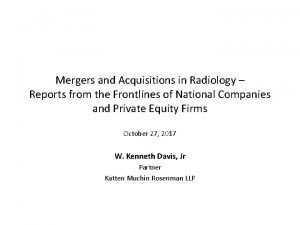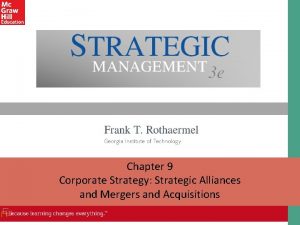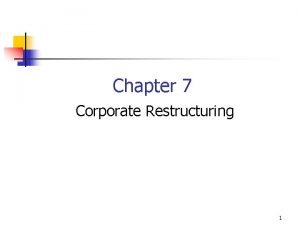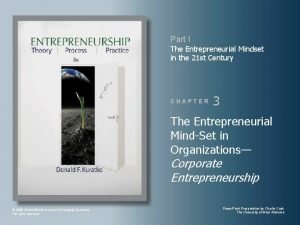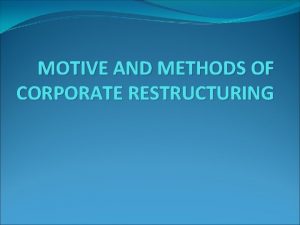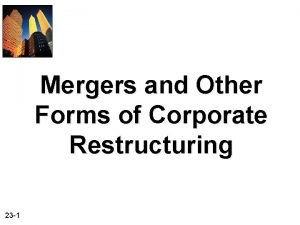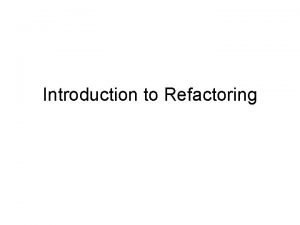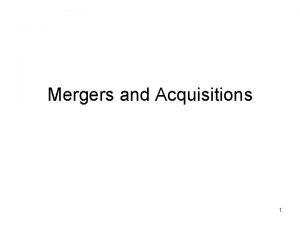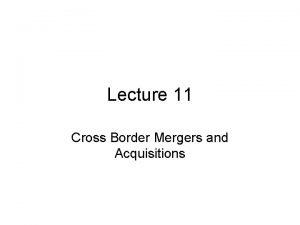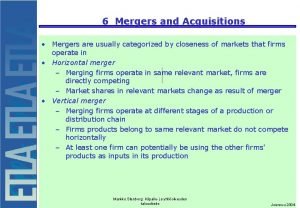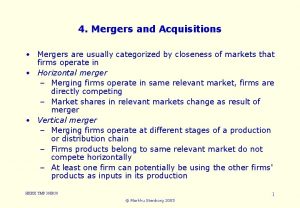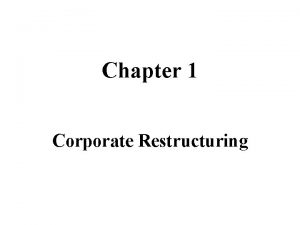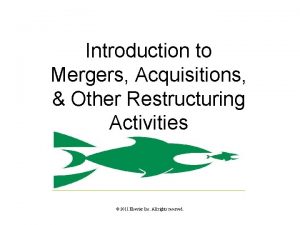Mergers Acquisitions And Corporate Restructuring SECOND EDITION Prasad


























- Slides: 26

Mergers, Acquisitions And Corporate Restructuring SECOND EDITION Prasad G. Godbole Copyright Publishing House Pvt. Ltd. rights reserved. Copyright©© 2009 2013 Vikas Prasad Gajanan Godbole. All rights reserved.

SECTION 3 ACCOUNTING AND TAXATION ASPECTS

Chapter 12 Accounting of Amalgamations and Demergers

When a company just acquires another company but does not amalgamate that company within itself, the shares purchased from the promoters and other shareholders are shown as ‘investment’ in the acquirer company’s books and are accounted at the cost at which they were acquired. In the target company’s books no adjustment is required at all. CHAPTER 12 Introduction

Amalgamation Demerger q Books of account and balance sheet of two (or more) companies are required to be combined. q The Institute of Chartered Accountants of India (ICAI) has issued Accounting Standard 14 (AS 14) which classifies different accounting methods applicable to different types of amalgamations. q Books of account and balance sheet of the demerged company are required to be split into two or more. q The ICAI has not prescribed any Accounting Standard. q The accounting norms for (tax neutral) demergers are stipulated in the Income Tax Act, 1961. CHAPTER 12 Accounting Fundamentals

CHAPTER 12 Accounting for Amalgamation

ACCOUNTING STANDARD 14 CLASSIFICATION OF AMALGAMATIONS METHODS OF ACCOUNTING CHAPTER 12 Accounting for Amalgamation

CHAPTER 12 (AS 14) Accounting for Amalgamations v The Standard deals with accounting for amalgamations and the treatment of any resultant goodwill or reserves. v The Standard does not deal with cases of acquisition which arise when there is purchase by one company (referred to as the acquiring company) of the whole or part of the shares, or the whole or part of the assets of another company (referred to as the acquired company) in consideration for payment in cash or by issue of shares or other securities in the acquiring company or partly in one form and partly in the other.

AMALGAMATIONS Amalgamation by way of Merger Amalgamation by way of Purchase CHAPTER 12 CLASSIFICATION OF AMALGAMATIONS

CHAPTER 12 Amalgamation by way of Merger • Five Preconditions for Merger: • All assets and liabilities of the transferor company become, after amalgamation, the assets and liabilities of the transferee company. • Shareholders holding not less than 90 percent of the face value of the equity shares of the transferor company (other than the equity shares already held by the transferee company or its subsidiaries or nominees) become the equity shareholders of the transferee company by virtue of the amalgamation. • The consideration for amalgamation received by those equity shareholders of the transferor company who agree to become the shareholders of the transferee company is discharged by the transferee company wholly by the issue of equity shares in the transferee company, except that cash may be paid in respect of any fractional shares.

CHAPTER 12 Amalgamation by way of Merger • The transferee company intends to carry on the business of the transferor company after the amalgamation. • No adjustment is intended to be made in the book value of the assets and liabilities of the transferor company when they are incorporated in the financial statements of the transferee company except to ensure the uniformity of accounting policies.

CHAPTER 12 Amalgamation by Way of Purchase An amalgamation in which any one or more of the five conditions mentioned earlier are not satisfied, then it is considered as amalgamation by way of purchase.

Methods of Accounting Pooling of Interest Method Purchase Method CHAPTER 12 METHODS OF ACCOUNTING

CHAPTER 12 Pooling of Interest Method • In case of an amalgamation by way of merger, the method prescribed is known as ‘pooling of interests method’. • Under this method following norms are required to be adhered to: v In preparing the transferee company’s financial statements, the assets, liabilities and reserves of the transferor company should be recorded at their existing carrying amounts and in the same form as at the time of amalgamation. v Even the reserves under various heads in the transferor company’s books have to be accounted under the same heads in the transferee company’s books. Thus, ‘revaluation reserves’ of the transferor company will become or get added to the ‘revaluation reserves’ of the transferee company and so on. v The difference between the amount recorded as the share capital issued (plus any additional consideration in the form of cash or other assets) and the amount of share capital of the transferor company should be adjusted in reserves.

ABC Limited has paid-up share capital of Rs 100 crore consisting of 10 crore shares of Rs 10 face value. XYZ Limited has paid-up share capital of Rs 50 crore consisting of 5 crore shares of Rs 10 face value. Decision has been taken to merge XYZ Limited with ABC Limited by using pooling of interests method. The pre-merger balance sheets of ABC Limited and XYZ Limited are given in Table 2 Market Price (MP), Book Value (BV) and Reinstatement Value of Net Fixed Assets per share (RV) of ABC Limited are Rs 80, Rs 65 and Rs 120 respectively. In case of XYZ Limited, the MP, BV and RV are Rs 240, Rs 130 and Rs 150 respectively. The firm of chartered accountants doing valuation has assigned weightages of 3: 1: 3 for MP, BV and RV respectively. Accordingly, the exchange ratio has been calculated as given in Table 1 below: (see on the next slide) CHAPTER 12 Example

CHAPTER 12

• CHAPTER 12 Purchase Method In amalgamation by way of purchase, while preparing financial statements, the transferee company is required to follow the ‘purchase method of accounting’. Under the purchase method following norms are required to be adhered to: A. With regard to assets and liabilities, the transferee company can (a) record the assets and liabilities of the transferor company at their existing carrying values, i. e. , book values or (b) allocate the consideration to the individual identifiable assets and liabilities on the basis of their fair values at the date of amalgamation.

The transferor company’s book value of net fixed assets is Rs 150 crore, book value of its net current assets is Rs 350 crore, its borrowed funds are of Rs 400 crore and the consideration paid in the form of share capital issued is Rs 200 crore. Here, the net book value of the assets works out to Rs 100 crore, against which the consideration paid is Rs 200 crore. The strict interpretation of the wordings in AS 14 suggests that Rs 100 crore of goodwill built into the consideration can be used to enhance the value of the individual assets up to Rs 100 crore provided such enhancement is up to their individual fair values. CHAPTER 12 Example

• B. CHAPTER 12 Purchase Method With regard to the reserves of the transferor company (whether capital or revenue), the transferee company should not include them in its books. Only exception to this is the statutory reserves such as debenture redemption reserves, which have to be shown in the transferee company’s books under the same account heads and at the same values as appearing in transferor company’s books at the time of amalgamation. On the other hand, any excess of the consideration over the value of the net assets of the transferor company acquired by the transferee company should be recognized in the transferee company’s financial statements as ‘goodwill’ arising on amalgamation; whereas, if the amount of the consideration is lower than the value of the net assets acquired, the difference should be treated as ‘capital reserve’.

CHAPTER 12 Example Please refer to illustration under the pooling of interest method. It says that in case of XYZ Limited, RV, i. e. , reinstatement value per share of the fixed assets is Rs 150 per share. This means that the total reinstatement value of the fixed assets of XYZ limited is Rs 750 crore. Now, if ABC Limited decides to follow the purchase method and decides to account for the fixed assets at Rs 750 crore, instead of their written down value (WDV) of Rs 610 crore and also decides to account for other assets and liabilities at book values, the balance sheet of ABC Limited after amalgamation will be as shown in Table 3.

continued……. Please note the following things in reference to Table 3: Due to the restatement of net fixed assets at Rs 750 crore, the total value of assets has gone up by Rs 140 crore. Accordingly, total reserves at Rs 1240 crore are higher by Rs 140 crore as compared to pooling of interest method (refer to Table 2) where they are Rs 1100 crore. However, under the pooling of interest method the entire reserves of Rs 1100 crore are free reserves, whereas, in the purchase method free reserves are only Rs 550 crore and capital reserves are Rs 690 crore. CHAPTER 12 Example

CHAPTER 12 Purchase Method C. With regard to the norm of crediting the difference between the consideration paid and net value of assets to ‘capital reserve’ (where consideration is less than net value of assets), there is a loophole provided in the AS 14 itself. D. With regard to the goodwill, if any, as created above, AS 14 requires the said goodwill to be amortized over its useful life but not exceeding five years. E. AS 14 also provides that where the statutory reserves of the transferor company have been recorded in the financial statements of the transferee company under the same accounting heads as in the books of the transferor company, a corresponding debit should be given to the ‘amalgamation adjustment account’, which should be disclosed under the ‘miscellaneous expenditure’.

CHAPTER 12 Accounting for Demerger

CHAPTER 12 Accounting for Demerger The ICAI has, as yet, not prescribed any accounting standard for demerger. However, ironically, the Income Tax Act, 1961, has defined the accounting norms for demerger.

CHAPTER 12 Accounting for Demerger The Act stipulates that all the assets and liabilities of the undertaking being demerged must be transferred to the resulting company and must be transferred at book values only. If any asset of the undertaking being demerged has been revalued, such revaluation needs to be ignored. This means that while transferring to the resulting company the assets of the undertaking being demerged, which were earlier revalued, have to be restated at cost (less accumulated depreciation in case of fixed assets). A peculiar situation would, however, arise if the company has already capitalized these reserves by the issue of bonus shares. In such a case, the transferor company would end up adjusting the diminution in the value of assets against its general reserves.

CHAPTER 12 Accounting for Demerger Transfer of Liabilities and Loans Specific liabilities of the undertaking being demerged have to be transferred to the resulting company. Specific loans or borrowings including debentures raised, incurred and utilized solely for the activities and operations of the undertaking being demerged have to be transferred to the resulting company. Common loans and borrowing have to be apportioned to the resulting company in the same ratio as the book value of the assets transferred to the resulting company bears to the total book value of the assets of the demerged company prior to demerger.
 Form of corporate restructuring
Form of corporate restructuring Radiology mergers and acquisitions
Radiology mergers and acquisitions Hr issues in mergers and acquisitions
Hr issues in mergers and acquisitions Franchise mergers and acquisitions
Franchise mergers and acquisitions Mergers in strategic management
Mergers in strategic management Mergers and acquisitions rumors
Mergers and acquisitions rumors In terms of the build borrow or buy framework
In terms of the build borrow or buy framework What is mergers and acquisitions
What is mergers and acquisitions Forbes mergers & acquisitions
Forbes mergers & acquisitions Debt restructuring meaning
Debt restructuring meaning Divestiture in corporate restructuring
Divestiture in corporate restructuring Entrepreneurship chapter 3
Entrepreneurship chapter 3 In restructuring corporate thinking top management should
In restructuring corporate thinking top management should Techniques of corporate restructuring
Techniques of corporate restructuring Forms of corporate restructuring
Forms of corporate restructuring Corporate entrepreneurial mindset
Corporate entrepreneurial mindset Objectives of corporate governance
Objectives of corporate governance Corporations mergers and multinationals
Corporations mergers and multinationals Gregor andrade
Gregor andrade Mergers and takeovers tutor2u
Mergers and takeovers tutor2u Clear thinking and writing second edition answer key
Clear thinking and writing second edition answer key Purchase cycle audit
Purchase cycle audit Audit of the capital acquisition and repayment cycle
Audit of the capital acquisition and repayment cycle United states acquisitions and annexations 1857-1904
United states acquisitions and annexations 1857-1904 Alliances and acquisitions
Alliances and acquisitions Refactoring and restructuring methods
Refactoring and restructuring methods Sujata madan
Sujata madan

